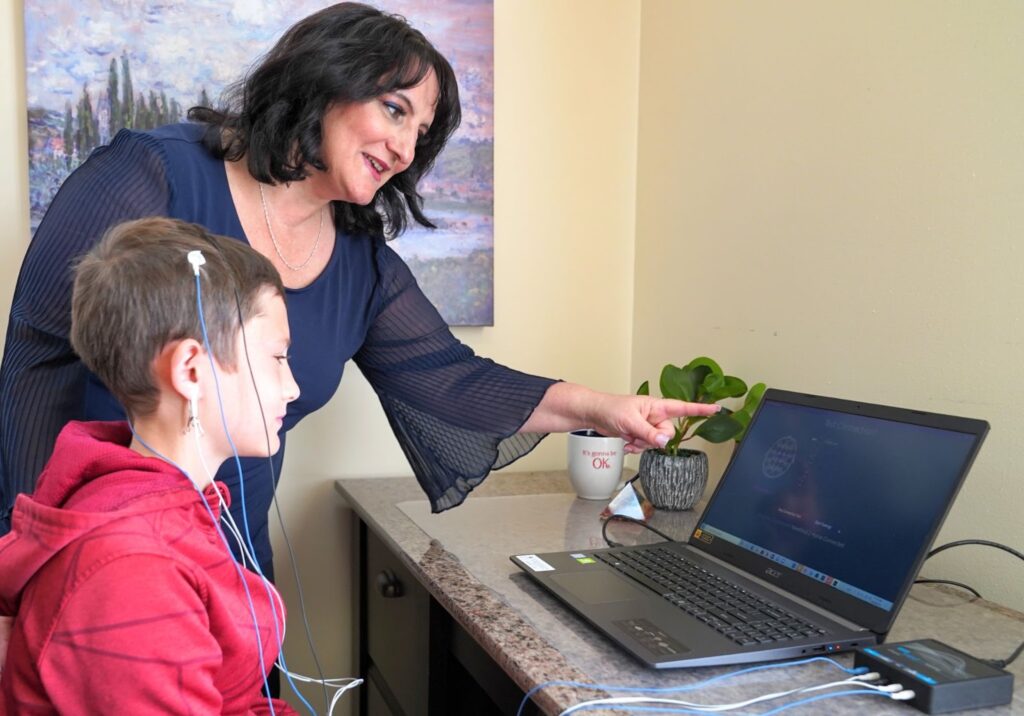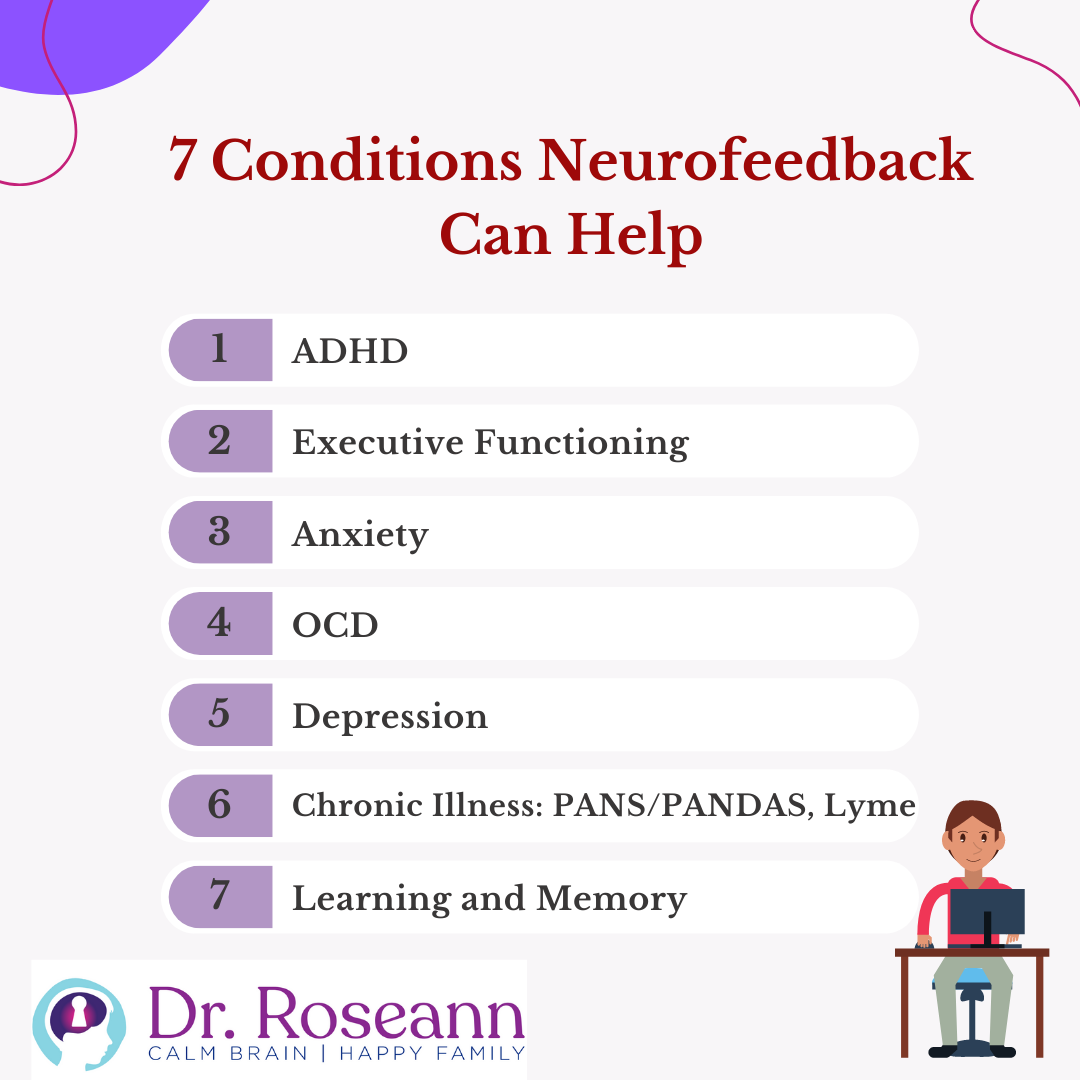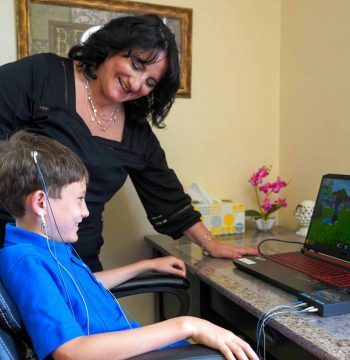What is Neurofeedback Good For?
There are many clinical symptoms that show the brain is not calm and balanced including, worry, sleeplessness, irritability, agitation, anger, stress, distractibility, problems with focus, low motivation, memory issues and a long list of common issues that kids and adults alike face. Psychiatric disorder and clinical symptoms are on the rise.
For some they find a way to help their children or themself to manage these issues but many are looking for the key to unlock their brain’s potential so they can feel calm, focused, and happy. Neurofeedback is that key for many clinical conditions because it is a safe and effective way to calm the brain and nervous system.
There are thousands of neurofeedback research studies that demonstrate just how effective neurofeedback training is for many clinical conditions and improving brain functions. You don’t need a clinical diagnosis to do neurofeedback, you just have to have a desire to want your brain to work better.
What Can Neurofeedback Treat?
The research shows us that there are dozens of clinical issues and conditions that can be treated with neurofeedback and at our Connecticut neurofeedback center we treat people in-person and virtually with at home neurofeedback. Here are some of the most common issues that neurofeedback can treat in children, teens, and adults that can create lasting positive effects on mood, focus, and behavior.
#1 ADHD
Of all the conditions kids face today, Attention Deficit Hyperactivity Disorder (ADHD), has become an increasingly common challenge for kids across the globe. According to 2021 data from the CDC, “9.4% of children aged 2-17 years (approximately 6.1 million) have received an ADHD diagnosis” and “7.4% of children aged 3-17 years (approximately 4.5 million) have a diagnosed behavior problem”. That means that at least 2 to 4 children in every class in America struggle with attention or behavior disorders.
Research demonstrates that one in five children with ADHD don’t receive needed school-based interventions, which means learning, getting along with others, and staying and completing tasks in the academic setting is hard. Schools and parents alike struggle for solutions and yet the numbers of children with self-regulation issues continue to rise every year.
Just like the research demonstrates, at our center we successfully use neurofeedback for ADHD to unlock children’s potential by calming the brain to create happy families. Meta analysis research shows us that neurofeedback improves adhd symptoms such as inattention, impulsivity, and hyperactivity.
The neuroscience of ADHD is a brain that has too many unfocused brainwaves and not enough focused brainwaves to sustain their focus during low interest tasks. Without focused attention, following the sequential and/or layered steps needed to complete a task, shifting attention, and controlling impulses is inconsistent at best.
The brain needs to be alert enough to pay attention to what they are doing in order to be successful and neurofeedback therapy is something that every parent should consider to help their child do better at school, home and in life.
#2 Executive Functioning
Neurofeedback has been shown to improve the executive functioning of children with ADHD and autism. Just as we see in our BrainBehaviorReset™ Program, research shows us that when you pair neurofeedback with cognitive training, executive functioning improves.
There are many reasons why one’s executive functioning can be impaired, including ADHD, anxiety, etc. but regardless of the source, the symptoms are the same and reflect a dysregulated nervous system and brain that needs calming. Simply put, only when the brain is calm, new learning is possible, so you need to calm the brain and teach a person new skills. A person can learn good executive functioning skills when directly taught.
#3 Anxiety
Feeling anxious and stressed has become a cultural norm that many accept because they don’t know another option. Stress and prolonged stress in particular, causes the nervous system to become hyperactive and “stuck” in an easily activated state where learning literally is physiologically hard if not impossible at times.
Neurofeedback calms anxious brain activity quickly and produces lasting changes that allows kids to be focused, get control of their anxious thoughts and let go of all of the physical signs of anxiety such as belly aches, heachaches, sleep problems, etc. Neurofeedback regulates both the structures of the brain and how the brain communicates from site to site. The neuroscience of anxiety disorders is that the brain is on fire with all this inner chatter, anxious thoughts and body sensations.
#4 OCD
Obsessive Compulsive Disorder (OCD) is one of the most missed and misunderstood clinical conditions that people face and therefore getting proper treatments means you have gone down a lot of rabbit holes.
There are many myths about OCD, but the one that gets in the way of people really getting help is not understanding what OCD really looks like. OCD always starts with intrusive thoughts and because they are internal, they simply are hard to spot. It is only when those intrusive thoughts morph into compulsive behaviors and rituals that parents and professionals identify what is really going on.
Being that our center specializes in OCD and PANS/PANDAS, we see OCD everyday and see how often it is missed by other professionals. OCD behaviors form with behaviors related to the habituation of the nervous system and will become increasingly treatment resistant overtime as a person lacks those skills to self-regulate and “talk back to their OCD”.
For those with OCD, we pair eeg neurofeedback with new brain learning through exposure and response prevention (ERP) OCD therapy, which calms brain wave activity to give a person the ability to respond to and learn new ways to address intrusive thoughts, compulsive thoughts and behaviors, and rituals.
#5 Depression
Depression can stem from many sources including long-term chronic anxiety, physical illnesses such as chronic pain, Lyme Disease, genetic mutations, genetic inheritance, and so on. When someone faces depression, it has a big impact on their life in some way at school or work, getting along with others, learning, and their home life.
Just like anxiety and OCD, depression can be hard to see but there are some behavioral signs. For internalizers, you may see withdrawn behaviors, low motivation, fatigue, lack of self-care, or tearfulness. With internalizers you may witness crankiness, anger, mood lability, or aggression. Children that struggle with mood are often difficult to parent and may have a history of ADHD, oppositional defiant disorder (ODD), or anxiety.
Neurofeedback for depression works to calm mood and behavioral dysregulation while at the same time improving alertness, impulse control, and a positive outlook. It is really hard for a person with depression to make positive behavioral change when their brain is in a sluggish or agitated state and neurofeedback restores a balanced calm for a person to do just that.
#6 Chronic Illness
The U.S. National Health and Nutrition Examination Survey (NHANES) found that autoimmune conditions in the US population are rising. The researchers found that the prevalence of the most common biomarker of autoimmunity, antinuclear antibodies (ANA), was significantly increasing in our population. Adolescents, ages 12-19, had the largest ANA increases in the study, increasing three-fold.
The dramatic rise in autoimmune disorders coincides with the rise in mental health conditions as there is a link between inflammation and mental health. The research shows a direct relationship between inflammation in clinical conditions such as anxiety, depression, OCD, PANS/PANDAS, autism, chronic pain, post concussion syndrome and others. The good news is that when you lower inflammation, you reduce symptoms and neurofeedback can help.
By getting the central nervous system to go from a stressed sympathetic dominant state into a calm parasympathetic state, the body is able to move its resources that were in a “war state” to do the work of the body. In the case of chronic illnesses such as PANS/PANDAS, Lyme Disease, and other chronic disease states, the field of psychoimmunology shows us that the body can’t heal itself when it is in a stressful state because its immune system, hormones, neurotransmitters, and nutrients all divert to calm down this stressor and will ignore known antigens.
Ah ha moment! That is why so many with autoimmune conditions just can’t seem to get better. Here is your next ah ha moment… Calming the brain and the body can turn on its own healing resources. At our center, we use neurofeedback sessions to support those with PANS/PANDAS, Lyme Disease, Tick-borne illness, and other clinical issues get their life back.
#7 Learning & Memory
My own experience with neurofeedback to amplify learning and memory has been dramatic. The increase in just how quickly I can process information is hard to describe. I often tell the kids I work with it is like being that character Quicksilver in the Xmen movies with my mind moving so fast that I feel like everyone else is working at a snail's pace. Ok, I started with a good foundation, so it was easy to get it to the next level (really 10 levels higher!).
With kids with clinical issues such as dyslexia, ADHD, and learning disabilities, learning and memory isn’t always easy. Neurofeedback works to improve how the brain communicates, which is always poor in the brain of a child with a learning disability. Not only does neurofeedback improve the efficiency of brain communication, it improves the function over the structures too. So for a child with dyslexia, neurofeedback can improve how the brain processes phonemes or their working memory, which will have a direct, positive effect on reading.
Always remember… “Calm Brain, Happy Family™”
Disclaimer: This article is not intended to give health advice and it is recommended to consult with a physician before beginning any new wellness regime.
Always remember… “Calm Brain, Happy Family™”
Are you looking for SOLUTIONS for your struggling child or teen?
Dr. Roseann and her team are all about solutions, so you are in the right place!
There are 3 ways to work with Dr. Roseann:
You can get her books for parents and professionals, including: It’s Gonna Be OK™: Proven Ways to Improve Your Child’s Mental Health, Teletherapy Toolkit™ and Brain Under Attack: A Resource For Parents and Caregivers of Children With PANS, PANDAS, and Autoimmune Encephalopathy.
If you are a business or organization that needs proactive guidance to support employee mental health or an organization looking for a brand representative, check out Dr. Roseann’s media page and professional speaking page to see how we can work together.
Dr. Roseann is a Children’s Mental Health Expert and Therapist who has been featured in/on hundreds of media outlets including, CBS, NBC, FOX News, PIX11 NYC, The New York Times, The Washington Post,, Business Insider, USA Today, CNET, Marth Stewart, and PARENTS. FORBES called her, “A thought leader in children’s mental health.”

She is the founder and director of The Global Institute of Children’s Mental Health and Dr. Roseann Capanna-Hodge. Dr. Roseann is a Board Certified Neurofeedback (BCN) Practitioner, a Board Member of the Northeast Region Biofeedback Society (NRBS), Certified Integrative Medicine Mental Health Provider (CMHIMP) and an Amen Clinic Certified Brain Health Coach. She is also a member of The International Lyme Disease and Associated Disease Society (ILADS), The American Psychological Association (APA), Anxiety and Depression Association of America (ADAA) National Association of School Psychologists (NASP), International OCD Foundation (IOCDF) International Society for Neurofeedback and Research (ISNR) and The Association of Applied Psychophysiology and Biofeedback (AAPB).
© Roseann-Capanna-Hodge, LLC 2023














